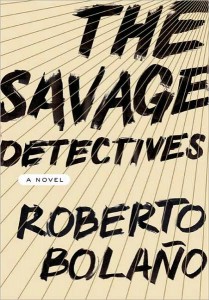 In 1998, Roberto Bolaño published Los Detectives Salvajes and unwittingly catapulted himself into the literary limelight, winning the Rómulo Gallegos International Novel Prize the following year, one of the most prestigious and lucrative of the world’s literary prizes. Nearly a decade would pass before the first English translation appeared, but Bolaño would not live to see it in print; he died of complications resulting from liver failure in 2003, just two months after his fiftieth birthday.
In 1998, Roberto Bolaño published Los Detectives Salvajes and unwittingly catapulted himself into the literary limelight, winning the Rómulo Gallegos International Novel Prize the following year, one of the most prestigious and lucrative of the world’s literary prizes. Nearly a decade would pass before the first English translation appeared, but Bolaño would not live to see it in print; he died of complications resulting from liver failure in 2003, just two months after his fiftieth birthday.
Fiction, for Bolaño, was a concession, not a passion. He once remarked that becoming a father necessitated a transition from poetry, his first love, to fiction, an art he seemingly held in contempt, or at least regarded with suspicion, for much of his life. And so he begrudgingly began to write fiction in a desperate effort to meet his increasing expenses, mining his bohemian life for story lines and characters. Born in Chile, Bolaño spent much of his youth in Mexico City, returning to his native country in 1973, mere months before Augusto Pinochet’s coup; he was promptly arrested on suspicion of terrorism and managed, by the sheerest accident, to escape execution or a lengthy prison sentence. The remaining few decades of his life were spent vagabonding in Spain, Mexico, France or El Salvador, a fact that helps explain the internationalist bent of his writing.
The Savage Detectives is the most transparently autobiographical of his works, centered around a group of aspiring young poets, the self-styled Visceral Realists, who spend more time stealing books, interrupting poetry readings or threatening to kidnap Octavio Paz, Mexico’s only Nobel literature laureate, than reading or composing poetry, and Bolaño takes great pleasure in parodying these literary upstarts, among whom is his alter ego, Arturo Belano, surely one of literature’s least inventive names (compare, for example, Joyce’s Stephan Dedalus or Vonnegut’s Kilgore Trout). Like his later and larger 2666, The Savage Detectives‘ narrative is fragmented, bookended by the journal entries of Juan García Madero, a teenage orphan abandoning his law studies in favor of the company of bohemian poets and prostitutes, and interspersed with several dozen other narrative voices, all of whom share their experiences with the founders and leaders of Visceral Realism, Arturo Belano and Ulisses Lima (Bolaño’s real-life friend Mario Santiago Papasquiaro) as they sell marijuana, flee from vengeful pimps and quest after Cesárea Tinajero, a female poetic forerunner whose life is shrouded in mystery.
Traditional narrative is shunned, reader expectations shattered and the conventions of the novel flouted with gleeful abandon as Bolaño constructs a work far greater than the sum of its disparate parts, a novel ambitious without being imposing; eminently readable even as it introduces new characters at every turn and abandons others for hundreds of pages; a monument to wastrel youth told with a mixture of lament and affection and containing, in miniature, a portrait of the artist as a young man. And yet, for all its autobiographical posturing, the novel refuses us the first-person consciousness of its protagonists, relegating their story to the impressions they leave on the novel’s many characters, some positive, some negative, others heartbreaking. Bolaño ultimately declines to be known, receding from the role of protagonist in his own story.